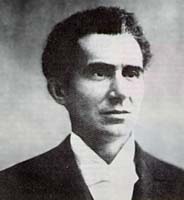

Year Born: 1851
Year Died: 1929
Pioneer
Berliner, Emile (1851-1929)
Born in Germany May 20, 1851, he first worked as a printer, then as a clerk in a fabric store. It was here that his talent as an inventor first came to surface. He invented a new loom for weaving cloth.
Emile Berliner emigrated to the United States in 1870 following the example of a friend. He spent much of his time at the library of the Cooper Institute where he took a keen interest in electricity and sound.
In the summer of 1876, there was an exposition in Philadelphia celebrating the 100th anniversary of the American Revolution. Many new scientific discoveries were presented, including Alexander Graham Bell’s very first telephone consisting of two identical cases containing an electro-magnet and a diaphragm connected by an electrical circuit. Unfortunately for Bell, the message transmitted wasn’t very clear. The invention had a good receiver but a poor transmitter.
Emile Berliner began his research in a small apartment in Washington which he transformed into an electrical laboratory. He even installed a telephone between his apartment and his landlady. The principle that Berliner discovered provided a good transmitter for Bell’s invention at any distance.
Berliner’s discovery was patented on June 4th 1877. In simple terms, he invented a primitive microphone. In September 1877 the Bell Telephone Company of Boston paid Berliner for his invention and put him on salary.
In 1883, he left the phone company and returned to Washington. He moved to a house on Columbia Street and set up a research lab there. It was there that he first invented his gramophone (patented 1887), horizontal (flat) records and a system for pressing records.
Berliner’s gramophone was presented for the first time at the Franklin Institute of Philadelphia. It was at this time he began to manufacture records. He invited musicians to record on zinc plates. In 1890, Scientific American published an article about his invention, illustrated by engravings of his gramophone and the machine that recorded the sound.
The gramophone was commercialized in 1883 by a company founded by Emile Berliner and some of his friends, The United States Gramophone Company. In the fall of 1895 a group of businessmen in Philadelphia put up $ 25,000.00 to set up the Berlin Gramophone Company. Emile Berliner was a minority stock holder and the copyright for the patent belonged to the company. Sales of the gramophone were lower than hoped and the company was quick to understand the need to improve the gramophone and equip it with a wind-up spring motor. Eldridge R. Johnson of Camden, New Jersey invented and manufactured this motor for Berliner Gramophone. Between 1896 and 1900 almost 25,000 motors were produced.
The Berliner Gramophone Company, which was inexperienced in the domain of marketing, signed an advertising contract with Frank Seaman of New York. Emile Berliner’s invention was now in the hands of three companies – The Berliner Gramophone Company (Philadelphia) who manufactured gramophones and records, The Seaman National Gramophone (New York) who oversaw advertising and marketing, and the United States Gramophone Company (Washington) who held the patents.
Early in 1900, Seaman’s National Gramophone negotiated an agreement with American Gramophone and Columbia Phonograph to manufacture the Gramophone. Berliner saw this agreement as a betrayal in view of the exclusivity contract he had previously signed with them. On June 25th 1900, Seaman filed an injunction against Berliner Gramophone which effectively prevented Emile Berliner from selling his gramophone in the United States. As a result of these problems, Berliner moved his company to Montreal. His grandson, Oliver Berliner, later explained in the Antique Phonograph News (1922), that Montreal was selected because of the ease of railway transport between there and Philadelphia.
Berliner set up his Montreal headquarters in 1900. First mention of the company appeared in Lovell’s Montreal Directory of 1900. At the time, their retail store and offices were located at 2315 St. Catherine St. and were under the direction of Emmanuel Blout. The factory was at 367 – 368 Aqueduc St.. (currently Lucien L’Allier St.) The oldest advertisement dates from November 1900 in the Canadian Magazine mentions that the gramophones were made in Canada. On December 22nd, 1900, Berliner Gam-O-phone Company (this is the spelling popularized in ads and which appeared on signs at the shop for many years) placed an ad in La Patrie which mentioned recordings were available in French. Another ad which appeared in the fall of 1900 told of a medal won at the Canadian National Exhibition in Toronto in that year.
On July 16th, 1900 Emile Berliner registered the trademark for his company, “Nipper” – the dog listening to a gramophone. The painter, Francis Barrand created this image which was used for more than 70 years. This trademark first appeared in Montreal on the back of record # 402 – “Hello My Baby”, by Frank Banta. Berliner produced 2,000 records during his first year of operation in Montreal. In 1901, he sold more than 2 million records.
In 1904 the company installed a recording studio at 138A Peel Street. The manufacturing plant moved to 201 Fortification Lane, while the shop and offices remained at St. Catherine Street. Between 1904 and 1906, the Berliner Gramophone Company produced several types of gramophones at the Montreal factory: the Model A, the Model B called the Ideal, model E called the Gem and the model C called the Grand.
This factory also produced 7″ (18 cm), 10″ (25.5 cm) and 12″ (30 cm) records. Early records had grooves for sound on only one side. The other side featured the now familiar image of “Nipper”, the dog. It wasn’t until 1908 that records had sound on both sides.
Joseph Saucier (1869 – 1941) had the honour of making the first Montreal recording. He sang the “Marseillaise”.
The first brick structure, situated on Lenoir Street dates from 1908. Sometime between 1908 and 1912, the company added an annex to the south. This latter building, considered, very modern for the times, was made of reinforced concrete and was four stories high, with very large openings. A large billboard perched on the top portrayed “Nipper” and read :The Home of the Victrola”.
The company saw a huge expansion after World War I, and a factory in St. Henri was enlarged. When construction of this building on St. Antoine was completed in 1921, Berliner Gramophone possessed one of the most modern factories in Montreal. The 50,000 sq. ft. plant made both players and records.
In 1924 the company was bought by Victor Talking Machine which merged in 1929 with R.C.A. to become R.C.A. Victor.
Emile Berliner died August 3, 1929 after a heart attack.
Written by Ross McCreath – 1998
